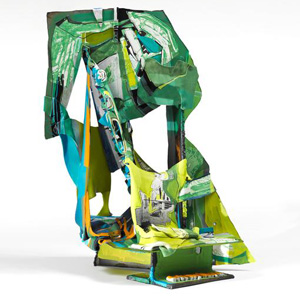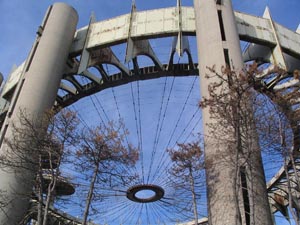6.9.25 — Is It Still Abstract?
You have seen it all by now, which is what makes it abstraction. Allow me a tour of some of its most creative and sometimes infuriating productions, with abstract art in Tribeca.
The up side is that it can push the artist to rethink the very nature of the image. Coming to Iva Gueorguieva, at Derek Eller through July 11, you could have no clue what you are seeing. These are more or less medium-sized paintings, but with a lot going on.  Is this formalism? Not exactly, but the more the artist works the surface the more it returns to the painting’s center in the human image.
Is this formalism? Not exactly, but the more the artist works the surface the more it returns to the painting’s center in the human image.
Gueorguieva layers on the canvas, with nearly white, wide-open fields that unify the whole. They serve, though, as a packed receptacle for brushwork as drawing. It dares you to decide whether the detail lands above or below. At first glance, the broader fields flatten the canvas and bring it closer to abstraction. Over time, though, they give a sense of a human or inhuman body. As paint it looks well grounded, but as image it can fly.
The gallery speculates that the figure is the archangel Gabriel, and once representation takes visible shape it is hard to make it disappear. Is there a story here? Maybe one about the art scene now that Postmodernism has given way to something less skeptical. Artists all over are turning to modernist tropes for their energy even if they seem more than a little old. Sarah Blaustein returns to the concentric swirls and spring colors of Post-Impressionism and early Modernism itself, recently at Hesse Flatow through June 7. You might be a trifle embarrassed to feel it in motion.
Robert Janitz relishes his place in the art world, even if you had hardly noticed him. Born in Germany, based in Mexico, and on view in Tribeca, he is proud of it. His latest work, “1001 Nights [ + 1 ],” claims the power of a mythmaker with its very title—and, with the bracketed subtitle, the power to one-up Islamic myth, at Canada through July 11. He sees himself as competing with the “swirling atmosphere” of New York. Never mind that most artists I know have resigned themselves to be pretty much out of the competition and faithful to their art. Janitz would call that surrender.
His gallery did as much as any to nurture artists between abstraction and portraiture like Katherine Bernhardt, Katherine Bradford, and Lily Ludlow, and Janitz hopes he has the formula. He lays down simplified bust-length portraits against a vaguely blank, vaguely patterned field as studies in brushwork itself. Then he packs what should be the face with broad, busy brushstrokes. They can roughly take the course of facial features or, in other paintings, take off on their own. Both sets of work serve simultaneously as marks of erasure and of three-dimensional space. An admixture of flour, oil, and wax keeps the colors mute and the faces in your face.
They leave me seriously unconvinced, but they only affirm how much painting still matters. Stick to abstraction or imagery and find yourself stuck with both. Or stop with abstraction as a metaphor—or a metaphor as abstraction. A map is an old metaphor for art indeed, and Lena Henke maps Manhattan as “The City Transformed,” at Bortolami annex through June 21. It looks ever so handmade, like a relic, as a nostalgic tribute to the city. So what if you cannot pin down just what about New York Henke is mapping, least of all its art?
Read more, now in a feature-length article on this site.

